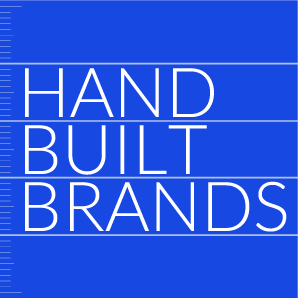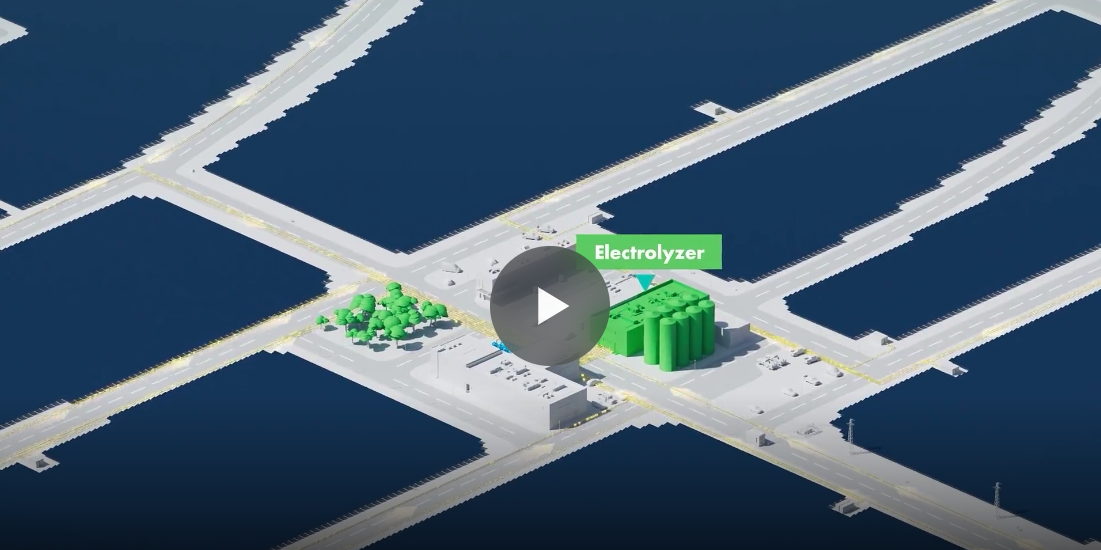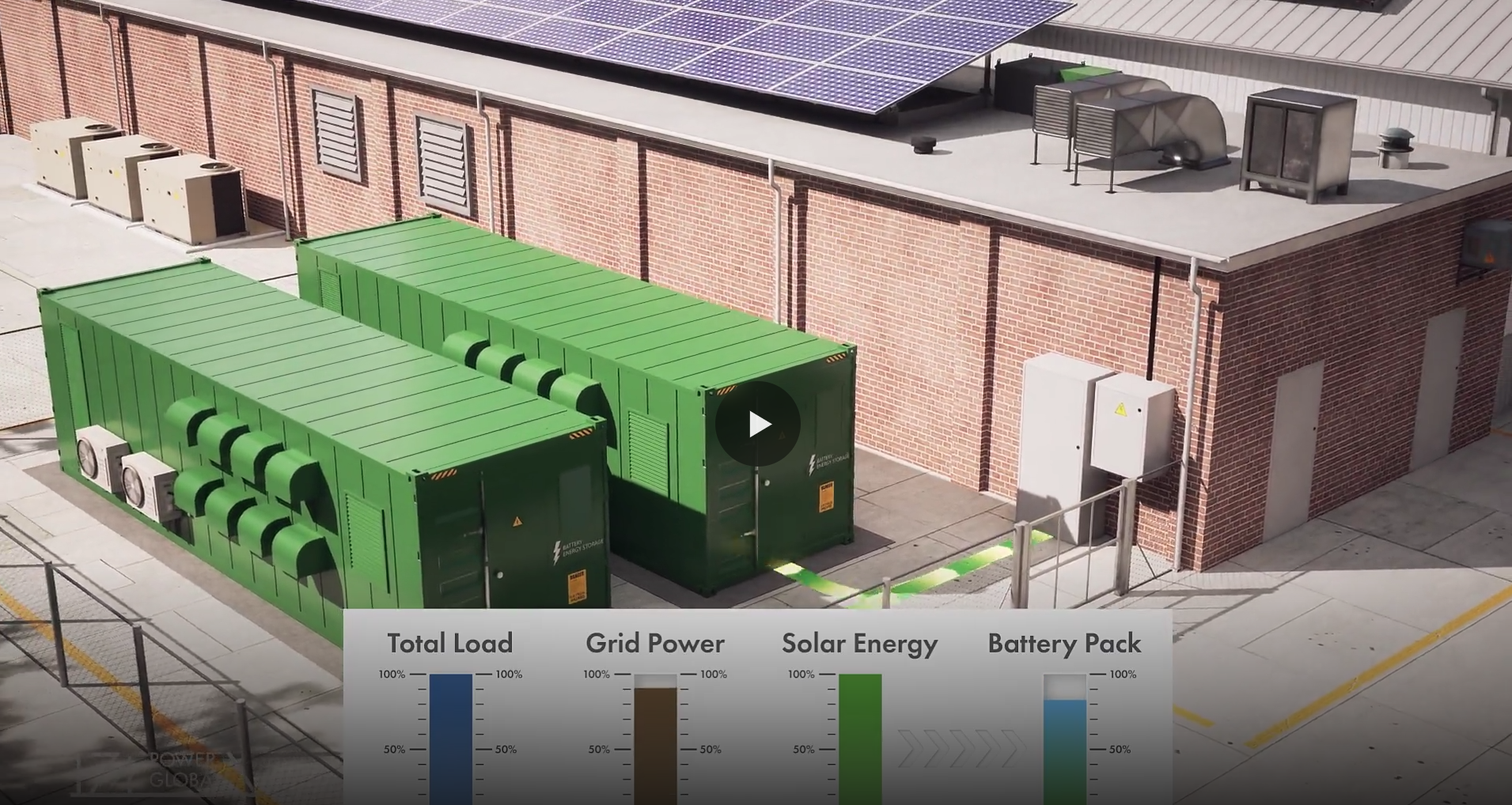Ecosystem
Pre-Production
Concept & Scripting
This project set out to visualize the invisible. The goal was to build a futuristic, data-forward conceptual animation that unpacks the behind-the-meter dynamics between labor, raw materials, and infrastructure—while placing them within the larger framework of environmental and economic impact.
The original concept centered on layered spherical geometry to represent concentric operational systems: procurement as the outer shell, infrastructure as the middle layer, and analytics at the core. This structure mirrored the idea that surface-level procurement often gets the attention (and budget), while the real operational value is buried deeper in infrastructure and analytics.
But strong ideas still have to function visually. The spherical model, while compelling in theory, hit friction points in clarity and navigation. So, during early look development, we pivoted to a ring-based geometry. This not only boosted legibility but also improved motion logic—camera paths became smoother, transitions between conceptual layers felt natural, and it became easier to map visuals to Markets, Infrastructure, and Analytics as distinct zones. Styleframes and moodboards explored this through architectural schematics, energy flow patterns, and live-data visualizations.
Visually, the design leaned into a dark base—navy and black—with sharp contrast hits from neon greens, oranges, and holographic blues. This look wasn’t just for flair. It was informed by references like sci-fi UI systems and modern energy dashboards, but more importantly, it aligned with the client's existing digital brand tone. Early on, there was discussion around keeping the animation grounded in a visual style that matched their site’s dark, technical aesthetic. Lighter concepts were explored, then shelved in favor of a more immersive, digital-forward design language.
Brand alignment wasn’t an afterthought—it was baked in from the jump. Avenir and Acumin were locked in for all on-screen text, and any deviations due to baked-in static elements were flagged and manually corrected. Custom iconography and visual assets were also swapped in wherever the brand had preferred versions. Color usage followed brand guidelines closely, with the understanding that lighting, transparency, and 3D material effects could shift tone slightly. Still, the aim was clear: preserve the integrity of the brand’s blues and oranges in all key frames and transitions.
Script and scene layout evolved side by side. The storyline centered on the idea that true cost and efficiency live behind the meter—and that shaped every visual choice. Transitions, icon moments, and data visualizations were carefully tied to narration cues. Key sequences, like zooming from factory-level data to high-level ESG overlays, were storyboarded to sync camera moves with voiceover beats.
Rapid Prototyping
Once scripting and visual direction were set, we moved into Rapid Prototyping (RP). This phase was all about speed and validation—testing pacing, camera flow, and layout logic using lightweight, low-poly builds.
The city itself started as modular blocks, which were then procedurally bent into a ring structure. Several C4D methods were tested to make sure deformation didn’t break the design—maintaining verticality and visual complexity even as elements warped. Feedback led to tweaks in object spacing, data density, and shape complexity to keep scenes readable without losing depth.
For the “data behind the meter” sequence, we used cloner systems and shader effectors, volumetric cylinders and bar graphs that were animated with procedural noise to simulate live, reactive data. This added an ambient, living feel to the environment—data was always moving, always adjusting, driving home the concept of transparency and operational awareness.
The central analytics node came into focus here as well—a stylized core that received and filtered incoming data, surrounded by pulsing UI callouts and analytics curves. Placeholder versions of these curves were layered into RP animations to test balance and responsiveness against VO timing.
In parallel, After Effects was used to start roughing in overlays—infographics, ESG callouts, historical charts, and cost comparisons. Camera data from C4D was ported over to AE to ensure clean 2D/3D tracking from the jump. Even in this early phase, that tight integration helped align the look and feel of complex overlays.
Key Visual Tests and Feedback Integration
The RP phase doubled as a test lab for visual transitions—most notably the shift from a raw cityscape to a fully activated “smart city.” The first pass used a MoGraph-driven material swap to move buildings from opaque dark blue to semi-transparent blue-green with inner glow. That evolved into a more layered approach after feedback: a procedural green energy wave now sweeps the city, triggering the transition more organically. Static frames of alternate versions were rendered and reviewed before finalizing direction.
Another piece of client input shaped the environment more directly: the need for clearer industrial representation. To answer that, RP scenes were updated to include a factory setup with conveyor belts and internal machinery—shown alongside more generalized smart buildings. That adjustment directly influenced the modeling strategy and asset complexity headed into full production.
Camera animation was carefully built to work with the circular layout. Fly-throughs followed curved splines, keeping motion smooth and ensuring each layer—buildings, data, overlays—remained legible and dynamic throughout.
Temporary VO reads and music beds were dropped in during RP, allowing us to adjust animation timing, camera moves, and even pulse rates on data visualizations. Every shift in narration prompted a visual realignment, which is exactly why RP stayed open and collaborative through multiple rounds.
Client Feedback Loop
Key suggestions included adding clearer distinctions between standard buildings and factory structures, improving color fidelity in early scenes to stay closer to brand hues, enhancing green overlays during ESG-focused moments, adjusting UI placement and label angles for better readability, and fixing font and icon inconsistencies across screens.
Each item was addressed directly in RP using test frames, AE overlays, or updated geometry. That iterative approach made sure everything was aligned before moving into heavier production rendering.
By the end of RP, the framework was locked. we had a validated visual blueprint: camera paths, scene durations, overlay positions, and data interaction systems were all nailed down. Shader design, animation blocking, lighting strategy, and final comp structure were built off this foundation. And the VO cadence? Fully dialed in.
Full Production
Look Development
With the rapid prototype locked and approved, we shifted focus to dialing in materials and visual fidelity using Cinema 4D and Redshift. The shader pipeline expanded significantly, introducing a dual-material system: one for core infrastructure—dark, glossy, subtly reflective—and another to visualize real-time digital systems using semi-transparent, holographic effects.
Early look development zeroed in on the need to differentiate passive infrastructure from live, data-active systems. The standout material was a custom glass-like shader used across UI-driven buildings, ESG blocks, and analytics cores. Built with procedural layers, animated Fresnel highlights, and emissive maps tied to MoGraph effectors, the shader brought depth and interactivity. Lighting tests combined studio HDR environments and custom key lights to maintain visibility and punch within the dark blue color scheme.
Shader transitions weren’t just aesthetic—they were structural to the animation’s storytelling. Dormant buildings “activated” using animated gradient masks triggered by MoGraph fields. These transitions matched camera moves and UI overlays, allowing elements to dynamically shift from matte-blue to transparent blue-green with glowing edges.
The glass shader included procedural line textures that bent with object curvature—wrapping windows, doorframes, and rooftops—to highlight architectural form without compromising the transparency effect.
Inside those glass surfaces, tiny gridded lines, dot arrays, and soft Fresnel fades simulated digital circuits and live transmissions. Animated emissives added glow trails, flickers, and value surges inside Legend’s analytics cores. The shaders were scripted to shift states based on camera proximity and scene progression—especially during transformation sequences.
One subtle detail that amplified realism: internal volumetric cues. ESG cubes and data processors were layered with emission and bump maps—“greeble textures” that gave the illusion of rich interior systems without adding heavy geometry. These micro-details suggested density, computation, and depth—key to sustaining the futuristic tone.
The shader approach extended across all animated objects. Even city traffic—semi-transparent green-blue vehicles—carried custom glow maps to preserve the project’s visual consistency.
Design & Animation
With shaders finalized, we upgraded every scene with full-detail assets. The city ring was rebuilt from proxy models into high-resolution structures. Buildings got architectural fidelity—complete with windows, segmented façades, rooftop HVAC units, and doors—while staying abstract enough to maintain visual clarity.
Buildings were instanced and bent into a ring using deformers and custom segment workflows. Topology cleanup was critical here—removing artifacts at curve joins while preserving enough geometry to support smooth animation.
Traffic systems followed spline paths and were animated with MoGraph cloners and offset effectors. Vehicle speeds varied slightly to suggest realism, and shader pulses showed which were active vs. dormant.
Camera paths were engineered to maintain cinematic smoothness across a geometrically complex space. Instead of straight-line dolly moves, cameras followed eased curves and circular constraint paths. Parent-null systems gave full control over orbit, zoom, and spiral motions—ensuring critical elements stayed in frame and readable.
Subtle background animation brought energy to each scene—light pulses, data flickers, and glow ripples moved through energy conduits and key analytics points.
In data-centric scenes, processor cores were rigged to “respond” to incoming flows—animated using MoGraph fields, cloners, and layered shader states. These sequences matched key VO lines and showed data activation, analysis, and ESG engagement.
Technical Details
All animation work ran through Cinema 4D, with rendering in Redshift. Each render pass included multiple AOVs—diffuse, specular, emission, object buffer, and Z-depth—for detailed control in post. C4D camera data and nulls were exported to After Effects to keep overlays and graphics tightly aligned with 3D geometry.
UI overlays and lens-matched animations used parented 3D nulls to ensure clean tracking with building shapes, processor interiors, and data flows.
Object buffers powered region-specific shader transitions. The large-scale “energy activation” wave used Z-depth and vertical gradient masks to simulate infrastructure shifting from offline to live.
Lighting setups mixed HDRIs with directional keys to maintain control in deep, high-contrast scenes. Reflective elements—especially holographic shaders—required fine-tuned lighting to prevent blown-out visuals.
Particles and glows triggered through a mix of keyframe MoGraph fields, procedural time noise, and interactive geometry triggers.
Collaboration & Revisions
Throughout production, we shared single-frame renders of key scenes for client review. These included ESG cores, factory processors, fly-throughs, and platform transitions. Revisions included: Optimizing factory layouts for better flow visuals, Adding rooftop solar indicators, Enhancing “greenification” overlays, Refining glow transitions to sync with analytics beats.
Brand alignment checks were ongoing: ESG text alignment, glow tone adjustments, and solar elements were all updated based on feedback. Fonts, icons, and color palettes were checked against guidelines—Avenir for all type, and brand-matching blues, oranges, and greens across glows and overlays.
Challenges & Solutions
Rendering and scene complexity presented the biggest hurdles. The infrastructure ring was heavy with instanced geometry and high shader detail. To stay efficient, scenes were rendered locally, with final frames offloaded to render farm using tracked resource caps.
Keeping clarity in data-dense scenes was another challenge. Glow and UI elements were carefully balanced in After Effects using Z-depth layers, masks, and manual sort orders to control what stayed in focus.
Post-feedback revisions—like the dual ESG building scene and green wave transitions—were handled via localized region renders, keeping updates efficient and on track.
Post-Production & Delivery
Final Compositing & Color Grading
Compositing was handled in After Effects using a non-destructive, node-based approach. All major render passes—specular, emission, depth—were layered and refined with post-grade color corrections, glow enhancements, and lighting adjustments.
Grading stayed true to the deep navy base, with glow effects and LUT transitions used to emphasize activation beats. Glowing greens and blues were animated to pulse in sync with energy sequences and data flow moments. Bloom and motion blur added realism during intense transitions.
Additional polish included digital flicker effects, subtle vignettes, and sharpness corrections across scenes to maintain a cohesive finish.
Infographics, UI Overlays, Data Visualization
Post was where the data story came to life. Using camera exports from C4D, we layered 3D-accurate overlays—charts, metrics, icons—directly onto building forms, processor units, and factory rigs. These weren’t floating UI elements. They bent with scene geometry, tracked with motion, and felt embedded in the infrastructure.
UI visuals took on a transparent, HUD-style look: radial graphs, line charts, bar metrics, and glowing KPIs. ESG and smart building scenes featured contextual overlays—linked to lighting units, HVAC processors, and structural dashboards.
One standout: a large circular analytics HUD inside the infrastructure core. Radial meters, pulsing rings, and animated segments reinforced the idea of real-time, centralized analysis.
Across the city, dozens of localized data metrics were layered using CC Particle World systems and pre-comped number sets—visually reinforcing the constant monitoring theme.
In the ESG data reveal, processor nodes fired off data trails into text overlays. These trails used Cinema 4D’s MoGraph fields and were enhanced in After Effects with glows and motion paths.
Zoom-out moments featured volumetric graph structures and HUD rings that gave the impression of full-system visibility. These geometric data layers pulsed with transparency and glow, syncing with narration to emphasize control and insight.
At the smart platform scene, UI dashboards lit up with toggled ESG metrics, animated KPIs, and scrolling values—simulating a live control panel.
The penny-to-data sequence included micro-thread connections showing hidden cost complexity—animated dynamically to show cost accumulation and inefficiency trails.
All text and numeric elements were animated with flicker frames and soft noise to suggest constant updates and a living, breathing data system.
Ensuring Brand Consistency
Every design element was checked against the client’s brand guide. Avenir was used throughout; rasterized text from screenshots was manually rebuilt when needed. Color fidelity was carefully monitored—ESG glows, UI hues, and analytic overlays all aligned with brand-approved tones, factoring in HDR and transparency shifts.
Legend’s latest icon set was integrated where applicable. Rooftop solar symbols were added to logical surfaces and repositioned based on review.
Collaboration & Revisions in Post
Post-production ran in close collaboration with the client. Feedback checkpoints used frame exports and Wistia updates. Adjustments included adding a second building for ESG clarity, tweaking the color of opening text blocks, strengthening the green energy wave sequence and adjusting rooftop solar indicator placement. Most changes were contained to specific sequences, avoiding broader re-approvals. Re-renders were localized and completed efficiently.
Delivery
The final video was exported in formats optimized for digital presentation—specifically tailored for embedding on the client’s website and for use in presentations.
Transcript:
The biggest impacts to every business’s bottom line are also the biggest drivers of energy cost. Labor efficiency, raw material consumption, and equipment efficiency. These are the primary drivers of cost as well as the biggest driver of your operations’ market risk and environmental impact.
Unfortunately, a majority of customers and their energy advisors have no transparency into what is going on behind the meter in real-time. So they rely on historical data as the basis for market purchasing decisions, operational decisions, and ESG reporting. This is like trading stocks based on last year's newspaper.
To make things worse. Most energy advisors who focus on procurement use this complexity and lack of transparency to embed hidden costs and fees and your energy contracts. This wasted capital could be better directed at demonstrable efficiency behind the meter.
Legend brings unprecedented transparency to energy markets, infrastructure projects, and real-time data, letting you look at your real labor, raw material, and equipment efficiencies behind the meter. Finally, equipping you with the information you need to understand how to lower costs and minimize environmental impact.
We not only make environmental, social, and governance data transparent and simple to measure but also actionable and accountable.
Our customers are becoming leaders in sustainability across sectors, driving down cost, resource intensity, and environmental impact. As more customers join the movement to lower market volatility and resource intensity, it allows society to move toward a more energy-efficient future. We are creating a sustainable ecosystem by fundamentally transforming the way humans and natural resources interact.
Join us.





